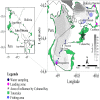Evidence of microplastics in water and commercial fish from a high-altitude mountain lake (Lake Titicaca)
- PMID: 36389423
- PMCID: PMC9653051
- DOI: 10.7717/peerj.14112
Evidence of microplastics in water and commercial fish from a high-altitude mountain lake (Lake Titicaca)
Abstract
Microplastic pollution is a widespread environmental concern. Like other anthropogenic pollutants, microplastics can reach aquatic ecosystems through rivers and interact with the aquatic biota. For instance, Lake Titicaca (between Bolivia and Peru), one of the great ancient lakes in South America (3,809 m a.s.l.), shows a pollution problem, particularly in the southern shallow basin (Lago Menor) in Bolivia. Nevertheless, our knowledge of the presence of microplastics and their interaction with the biota of Lake Titicaca is limited. Therefore, this study evaluated the presence of microplastics in the stomach content of the four fish species targeted by local fisheries in Lago Menor of Lake Titicaca (Orestias luteus, Orestias agassizii, Trichomycterus dispar, and Odonthestes bonariensis; N = 1,283), and looked for relationships with trophic guilds or fishing areas. Additionally, surface water was analyzed to evaluate the presence of microplastics in the water. The evaluation of microplastics was carried out by visual observations. We observed that the frequency of microplastic ingestion was low in all species (<5%). Conversely, microplastic was present in the water, with the highest quantity at the southern part of Lago Menor (103 ± 20 particles per L), without differences in the microplastic number between sites. Most microplastics counted in stomach contents were fibers, whereas water samples mainly contained fragments. Our results point to microplastic pollution in Lago Menor of Lake Titicaca. However, we could not determine the pollution rate due to considerable methodological limitations. Further research will be needed to robustly detect microplastics in Lake Titicaca and their impact on the fish species in the lake.
Keywords: Fibers; Fishery impacts; Orestias; Plastic pollution.
©2022 Loayza et al.
Conflict of interest statement
The authors declare there are no competing interests.
Figures





References
-
- Achá D, Guédron S, Amouroux D, Point D, Lazzaro X, Fernandez PE, Sarret G. Algal bloom exacerbates hydrogen sulfide and methylmercury contamination in the emblematic high-altitude Lake Titicaca. Geosciences. 2018;8:438. doi: 10.3390/geosciences8120438. - DOI
-
- ALT . Diagnóstico Binacional Pesquero y Acuícola en el ámbito del Sitema Hídrico Lago Titicaca. Lago Poopó y Salar Coipasa-TDPS; Río Desaguadero: 2020.
-
- Archundia D, Duwig C, Spadini L, Uzu G, Guédron S, Morel MC, Cortez R, Ramos ORamos, Chincheros J, Martins JMF. How uncontrolled urban expansion increases the contamination of the Titicaca Lake Basin (El Alto, La Paz, Bolivia) Water, Air, & Soil Pollution. 2017;228:44. doi: 10.1007/s11270-016-3217-0. - DOI
Publication types
MeSH terms
Substances
LinkOut - more resources
Full Text Sources

